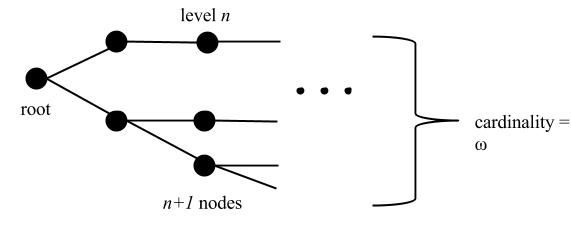As explained in the various comments,
every tree has countably many or $2^\omega$ branches,
there are trees with $2^\omega$ branches of any unbounded admissible growth rate $f(n)$, and
if nodes can have arbitrarily many children, there are countable trees of arbitrary growth rate.
As Joel already mentioned, the question that remains is for which growth rates $f(n)$ there exist trees with countably many branches where every node has one or two children. (Below, I will assume the latter condition automatically, and call them just “trees”.)
Now, even for this question, the absolute growth rate is largely irrelevant, what really matters is how $f(n+1)$ relates to $f(n)$, as demonstrated by the following example.
First, let me define for convenience that $f\colon\mathbb N\to\mathbb N$ is admissible if there exists a tree of growth rate $f(n)$. This is equivalent to the conditions
The question also demands $f(n)\ge n$, but as Joel notes, this has no good reason, so I will state this explicitly where intended.
Example:
For every function $g\colon\mathbb N\to\mathbb N^{>0}$ such that $\lim_ng(n)=+\infty$, there is an admissible function $f(n)\le g(n)$ such that every tree of growth rate $f(n)$ has $2^\omega$ branches.
There is an admissible function $f$ such that $n\le f(n)\le2n$ for $n>0$, and every tree of growth rate $f(n)$ has $2^\omega$ branches.
Proof: For 1, we can choose an infinite sequence $0=n_0<n_1<n_2<\dots$ such that $g(n)\ge2^k$ for every $n\ge n_k$, and define
$$f(n)=2^k\text{ for }n_k\le n<n_{k+1}.$$
If $T$ is a tree of growth rate $f(n)$, all nodes at levels $n_k-1$ split, hence $T$ has $2^\omega$ branches.
The argument for 2 is similar: we fix a sequence $n_0,n_1,\dots$ such that $2n_k<n_{k+1}$ for every $k$, and put
$$f(n)=\begin{cases}n&n\le n_0\text{ or }2n_k\le n\le n_{k+1},\\
2n_k&n_k<n\le2n_k.\end{cases}$$
Again, all nodes at levels $n_k$ split.
It is in fact possible to characterize exactly what growth rates allow for trees with countably many branches.
If $f$ is an admissible function, put
$$d(n)=2f(n)-f(n+1).$$
Note that $0\le d(n)\le f(n)$. If $T$ is a tree of growth rate $f$, then $d(n)$ counts the number of nodes at level $n$ that do not split.
A moment’s reflection reveals that if we want a tree of fixed growth rate to have as few branches as possible, we should try to put all splitting nodes on one side. With this in mind, define a tree $T_f$ of growth rate $f(n)$ as follows. The nodes at each level $n$ are numbered $1,\dots,f(n)$. Nodes $1,\dots,d(n)$ have one child each on level $n+1$, with the same number. Nodes $d(n)+1,\dots,f(n)$ have two children each, again numbered in the same fashion: that is, node $i>d(n)$ has children $2i-1-d(n)$ and $2i-d(n)$.
Theorem: For any admissible function $f$, the following are equivalent.
All trees of growth rate $f$ have $2^\omega$ branches.
$T_f$ has $2^\omega$ branches.
There are $n_0\le n_1<n_2<n_3<\cdots$ such that
$$\sum_{k=1}^\infty2^{-k}d(n_k)\le f(n_0)-1.$$
- There are $n_1<n_2<n_3<\cdots$ such that
$$\sum_{k=1}^\infty2^{-k}d(n_k)<1.$$
Proof:
$1\to2$ is trivial.
$2\to3$: If $b$ is a branch in $T_f$, let $b(n)$ denote the number of the node of $b$ at level $n$. We observe that $b(n)$ is nondecreasing. If $b'(n_0)<b(n_0)$, then $b'(n)<b(n)$ for all $n\ge n_0$. If $b$ does not split after level $n$, then neither does any branch $b'$ below it; thus $b$ is isolated if and only if $b(n)$ is eventually constant. Let $b_m$ be the branch which goes through node $f(m)-1$ at level $m$, and then follows the higher child at each level where it splits. Every branch of $T$ except the topmost one is bounded above by some $b_m$, thus if every $b_m$ were eventually constant, all but one branch would be isolated, and the number of branches would be countable. Thus, let us fix $n_0$ such that $b:=b_{n_0}$ is not eventually constant.
We can compute $b(n)$ by an explicit recurrence:
\begin{align}
b(n_0)&=f(n_0)-1,\\
b(n+1)&=b(n)+\max\{0,b(n)-d(n)\}
\end{align}
for $n\ge n_0$. Since $b$ is not eventually constant, we have $b(n)>d(n)$ for infinitely many $n\ge n_0$; let us enumerate them as $n_1<n_2<\cdots$. Unwinding the recurrence, we see that
$$b(n)=2^m(f(n_0)-1)-2^{m-1}d(n_1)-2^{m-2}d(n_2)-\dots-d(n_m)\qquad\text{for }n_m<n\le n_{m+1}.$$
Since $b(n)\ge0$, we obtain
$$f(n_0)-1\ge\sum_{k=1}^m2^{-k}d(n_k)$$
for every $m$, which implies 3 in the limit.
$3\to4$: We have
$$f(n_0)=2^{n_0}-2^{n_0-1}d(0)-2^{n_0-2}d(1)-\dots-d(n_0-1),$$
hence if we put
$$n'_k=\begin{cases}k&k<n_0,\\n_{k+1-n_0}&\text{otherwise,}\end{cases}$$
we obtain
$$1>1-2^{-n_0}\ge\sum_{k=1}^\infty2^{-k}d(n'_k).$$
$4\to1$:$\let\res\restriction\let\sset\subseteq\let\Sset\supseteq $
Let $T$ be a subtree of $2^{<\omega}$ of growth rate $f(n)$, $[T]\sset2^\omega$ the set of its branches, and $T_1\sset T$ the set of nonsplitting nodes of $T$. For any $b\in[T]\cup T$, let $B(b)\sset\mathbb N$ denote the set of levels on which $b$ goes through a splitting point of $T$. $b\res n\in2^n$ denotes the restriction of $b$ to the first $n$ levels.
We consider a probability measure on Borel subsets of $2^\omega$ defined by
$$\Pr_{\sigma\in2^\omega}(\sigma\Sset t)=\begin{cases}2^{-|B(t)|}&t\in T\\0&\text{otherwise}\end{cases}$$
for $t\in2^{<\omega}$. That is, $[T]$ has measure 1, and if $t\in T\smallsetminus T_1$, the measure of the set of all branches going through $t$ is split evenly between the two children of $t$.
Claim: If $b\in[T]$, we have
$$\Pr_\sigma(\sigma=b)\le\sum_{k:b\res n_k\in T_1}2^{-k}\Pr_\sigma(\sigma=b\mid\sigma\Sset b\res n_k).$$
Proof: We can assume wlog $\Pr(\sigma=b)>0$, which implies that $b$ is isolated. Let $k_1<k_2<\cdots$ be the enumeration of all $k$ such that $b\res n_k\in T_1$. Then
\begin{multline}
\frac1{\Pr(\sigma=b)}\sum_{k:b\res n_k\in T_1}2^{-k}\Pr_\sigma(\sigma=b\mid\sigma\Sset b\res n_k)=\sum_{j=1}^\infty\frac1{2^{k_j}\Pr(\sigma\Sset b\res n_{k_j})}\\=\sum_{j=1}^\infty2^{-k_j}2^{|B(b)\cap\{0,\dots,n_{k_j}-1\}|}\ge\sum_{j=1}^\infty2^{-k_j}2^{k_j-j}=1.
\end{multline}
Now, assume for contradiction that $[T]$ is countable. Using countable additivity of the measure, and the claim, we obtain
\begin{multline}
1>\sum_{k=1}^\infty2^{-k}d(n_k)=\sum_k\sum_{t\in T_1\cap2^{n_k}}2^{-k}\ge\sum_k\sum_{t\in T_1\cap2^{n_k}}2^{-k}\sum_{b\Sset t}\Pr_\sigma(\sigma=b\mid\sigma\Sset t)\\=\sum_{b\in[T]}\sum_{k:b\res n_k\in T_1}2^{-k}\Pr_\sigma(\sigma=b\mid\sigma\Sset b\res n_k)\ge\sum_{b\in[T]}\Pr_\sigma(\sigma=b)=1,
\end{multline}
a contradiction.



